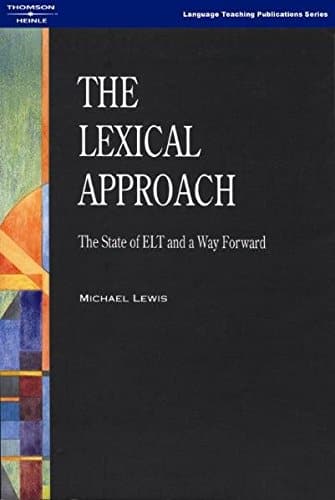
The Lexical Approach in Language Teaching
Which do you think is more important—advancing vocabulary or teaching grammar?
What if I told you that “neither” is a totally acceptable answer? At least that’s what linguist Michael Lewis of the lexical approach is saying.
These two facets of language—vocabulary and grammar—go together like peanut butter and jelly.
The lexical approach is a method of teaching that centers around the theory that language is composed of lexical “chunks” as opposed to grammar structures.
In this guide, I’ll explain more about what exactly the lexical approach is, and how you can go about implementing it in your classroom!
Contents
- What Is the Lexical Approach?
- Advantages of the Lexical Approach
- How to Use the Lexical Approach in Your Classroom
Download: This blog post is available as a convenient and portable PDF that you can take anywhere. Click here to get a copy. (Download)
What Is the Lexical Approach?
The lexical approach is more interested in word “chunks,” or phrases—words that usually go together and are commonly found next to each other in the language, rather than set grammar structures.
Linguist Michael Lewis literally wrote the book on the topic. His 1993 work, titled “The Lexical Approach: The State of ELT and a Way Forward,” put together the conceptual foundations for effectively teaching a second language.
There are plenty of “chunks” in English:
- by the way
- abstract reasoning
- complete idiot
- best wishes
- make up your mind
- go to great lengths
These words often go together and native speakers use them next to each other a lot.
The lexical approach posits that languages are composed of these “chunks” and that the key to fluency in any language is the nuanced use of these phrases—which native speakers spew in daily conversations—without regard for grammatical soundness or word meaning.
For example, how would you grammatically deconstruct phrases like “by the way” or “make up your mind”? In cases like these, grammar becomes an afterthought. But native speakers know they’re right because they sound right.
To illustrate this idea, think of the phrase “best wishes.” The word “best” in the phrase can be replaced with “good,” “happy” or “fun” and still be grammatically sound, but native speakers will know that something’s off and will use the word “best” anyway.
The lexical approach does away with the grammar/vocabulary dichotomy and instead presents linguistic fluency as the ability to readily and rapidly appropriate stock phrases to different situations. We build sentences and communicate by using thousands of these phrases. So, language teaching should reflect this reality in the classroom.
Advantages of the Lexical Approach
The lexical approach speeds up language acquisition
“Chunking” is actually a memory improvement technique. By grouping commonly co-occurring words and treating them as one larger whole allows the brain to process greater amounts of information.
Chunking allows your class to cover plenty of information quickly. Instead of your students individually processing every word in a sentence, what every word means and how each one grammatically relates to the word next to it, they’re dealing with chunks. Instead of building fluency one word at a time, you’re doing it one phrase at a time.
For example, instead of teaching “Hang in there!” as three meaningful words, you teach it as a canned expression which means “don’t give up.”
It’s eminently practical
“The green monkey jumped on the round table.”
When you were a student yourself, did you ever encounter sentence examples that made you think, “Yeah, I’ll never use that one in my everyday speech… ever.”
While it might have taught you the grammar concept, it didn’t teach you actual useful phrases you could use in everyday conversations.
With the lexical approach, your students get phrases and expressions that are good to go—pre-made expressions that native speakers readily understand and that can be used in daily conversations.
It teaches communication
The lexical approach is practical and immediately relevant. Instead of learning things about the language that speakers themselves don’t even know about, your students learn how to communicate in meaningful terms.
When your students find themselves face-to-face with native speakers, they’ll know how to greet them, how to ask them a question and how to tell a story or share personal facts.
How to Use the Lexical Approach in Your Classroom
1. Immerse students in authentic materials
“Authentic material” refers to natural exposure to the language that native speakers encounter every day.
“Authentic material” is different from language textbooks or tutorials that are created for language students. For example, in video tutorials, teachers slow down and enunciate the words clearly so that viewers can follow along. They also explain what each word means and give sentence examples.
This doesn’t happen with authentic materials. There’s the unspoken assumption that readers, viewers or listeners already understand the language, so they go at it full speed.
Immerse your students in authentic materials—real materials created for real native speakers.
One way to do this is through a language learning program such as FluentU. Your students will be able to watch a variety of authentic clips across a range of languages, each with dual-language interactive subtitles, so they can see in-context definitions for anything they don’t understand.
2. Highlight lexical chunks every chance you get
In the beginning, your students will find it challenging to judge for themselves which words in the sentences come as a group. It’ll be your job to highlight them.
For example, highlight the chunks when you write sentences like:
“It’s time for a quick shower.”
“I don’t like fast food.”
“The loss caused excruciating pain.”
Bring your students’ attention to the bolded words.
Highlight them or circle them on the board. Say them repeatedly and ask the class to repeat them as well. Isolate them from the other words in the sentence. Explain to students what they mean.
Give other examples when the phrase is correctly used, and let students know when the phrase would not be appropriate. For example, you can point out that even though “fast” and “quick” essentially mean the same, “fast shower” and “quick food” just don’t sound right.
3. Translate chunks from the target language to English (and vice versa)
To make the phrases come alive for your class, try to give students a sense of what their equivalent expressions are in English (or whatever language you’re teaching in). This would open their eyes to the many instances a particular lexical chunk is appropriate.
For example, the Spanish idiom “Entre la espada y la pared” which literally means “between the sword and the wall” is the equivalent of the English expression “between a rock and a hard place.” Highlight this in your discussions.
Of course, the conversion is never perfect, and there isn’t always a proper translation, but when the translation does exist, use it. These translations can be excellent jumping-off points for your discussions, so tell your class about English equivalents to the lexical chunks you talk about.
Idioms are excellent resources for these lexical chunks. Try to get a hold of an idiom dictionary for the language you’re teaching, like “The Big Red Book of Spanish Idioms,” “2001 French and English Idioms” or “German: Fast Track Learning from English Idioms.”
4. Incorporate earlier chunks in later lessons
You’re probably already familiar with “bridging” as a teaching technique: It’s simply reviewing old material you’ve taught before by incorporating it into the new lessons.
Let’s say the class learned prepositional phrases like “at the corner,” “in front of” and “go beyond” just a few days ago. When you’re up for a story or playing a fun language game, include these phrases in the activities so they’ll remain fresh in your students’ minds.
In a story, for example, you can say: “The princess was tempted to go beyond the gates. Remember this phrase, class? ‘Go beyond.’ Say it with me… Again! Okay, now back to our story.”
Your lessons should be a mix of old phrases that you review and new ones that you introduce. The reviews of past lessons will give students a whiff of the familiar and give them confidence, while the new ones will make things interesting and keep the learning process moving forward.
5. Invest in listening and reading activities
If you want to hone your class’ instincts of finding lexical “chunks” in the target language, you’ll need to give them a lot to read and listen to. (Even better if they can listen to something and have a copy of the text on hand.)
With repeated auditory exposure, their ears will become familiar with the rhythm and rhyme of the target language. Through a lot of reading, the naturally occurring phrases that pepper authentic material will begin to slowly pop out of the page and poke them in the eye (don’t worry, not literally).
Let them listen to language podcasts, audiobooks or songs.
Give assigned readings like newspaper articles, children’s books, even blog posts.
But don’t just let your class passively listen or read. Ask students to come up with a list of lexical phrases contained in the assigned material and go over them in class together.
These tips will help you work the lexical approach into your language classroom. With this approach, your students will acquire the target language faster, and they’ll sound more fluent, too! But don’t think this is the only tool in your box: all the other teaching strategies and approaches to foreign language teaching have a place in your repertoire as well. Used together, these tools will send your students hurtling towards fluency!
Download: This blog post is available as a convenient and portable PDF that you can take anywhere. Click here to get a copy. (Download)




